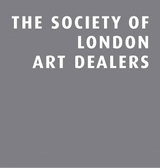Alexander Calder (1898 - 1976)
- AVAILABLE ARTWORKS FOR SALE
For more available works please contact us on stern@pissarro.com or +44 (0)20 7629 6662.
Alexander Calder, also known as ‘Sandy’ was born in 1898 in Philadelphia, his father and grandfather Alexander Stirling Calder and Alexander Milne Calder were both well-known sculptors. Described as an arbitrary choice, Calder originally gained a mechanical engineering degree at the Stevens Institute of Technology, where he acquired mathematical skills, which would later inform his ingenious approach to sculpture.
Calder had various jobs before enrolling at the Art Students League in New York City in 1923. In 1925, still a student, Calder worked for the National Police Gazette where his theme of the circus first began with an assignment to sketch the Ringling Brothers and Barnum and Bailey Circus.
In June 1926 Calder made his first wire sculptures at the Academie de la Grande Chaumiere in Paris. Most famously, Cirque Calder, a miniature circus that was animated by hand at performances given to friends. The work was well received by many of the Parisian avant-garde artists such as Fernand Léger, Jean Arp and Marcel Duchamp and also exhibited in New York in 1929 at the Haws-Harden apartment. His wire sculptures are characteristically colourful and finely crafted, often described as drawings made in space.
After visiting Piet Mondrian's studio in 1930 Calder was inspired by the abstract forms in Mondrian’s paintings. He would later become renowned for developing a new idiom in modern art called the ‘mobile’, where he made abstract art move.
In Early 1932 in an exhibition organised by Marcel Duchamp, who coined the word ‘mobile’, Calder displayed his first moving sculpture. Calder’s kinetic works range from being suspended and anchored, and are often monumental in size; he describes their performative element as “dancing in front of you”. Calder compared his stationary sculptures, dubbed ‘stabiles’ by Jean Arp, to traditional paintings as they simply imply movement. His exploration of motion in art began with using motors, but soon Calder used air-currents alone, creating movement he described as occurring "by nature and chance." The subtle, continuous movement of the suspended forms redefine the negative space around their abstract forms.
Today, Calder’s works inhabit many major cities in the world, including many large-scale outdoor sculptures. In addition to his revolutionary sculptural compositions, Calder also produced a wealth of drawings, oil paintings, watercolours, gouache, and created jewellery. As Calder's sculptural oeuvre shifted towards abstraction in the mid-1930s, his prints followed suit; colourful, geometric shapes predominate his works of this time. Calder died in 1976.
Read more
Calder had various jobs before enrolling at the Art Students League in New York City in 1923. In 1925, still a student, Calder worked for the National Police Gazette where his theme of the circus first began with an assignment to sketch the Ringling Brothers and Barnum and Bailey Circus.
In June 1926 Calder made his first wire sculptures at the Academie de la Grande Chaumiere in Paris. Most famously, Cirque Calder, a miniature circus that was animated by hand at performances given to friends. The work was well received by many of the Parisian avant-garde artists such as Fernand Léger, Jean Arp and Marcel Duchamp and also exhibited in New York in 1929 at the Haws-Harden apartment. His wire sculptures are characteristically colourful and finely crafted, often described as drawings made in space.
After visiting Piet Mondrian's studio in 1930 Calder was inspired by the abstract forms in Mondrian’s paintings. He would later become renowned for developing a new idiom in modern art called the ‘mobile’, where he made abstract art move.
In Early 1932 in an exhibition organised by Marcel Duchamp, who coined the word ‘mobile’, Calder displayed his first moving sculpture. Calder’s kinetic works range from being suspended and anchored, and are often monumental in size; he describes their performative element as “dancing in front of you”. Calder compared his stationary sculptures, dubbed ‘stabiles’ by Jean Arp, to traditional paintings as they simply imply movement. His exploration of motion in art began with using motors, but soon Calder used air-currents alone, creating movement he described as occurring "by nature and chance." The subtle, continuous movement of the suspended forms redefine the negative space around their abstract forms.
Today, Calder’s works inhabit many major cities in the world, including many large-scale outdoor sculptures. In addition to his revolutionary sculptural compositions, Calder also produced a wealth of drawings, oil paintings, watercolours, gouache, and created jewellery. As Calder's sculptural oeuvre shifted towards abstraction in the mid-1930s, his prints followed suit; colourful, geometric shapes predominate his works of this time. Calder died in 1976.

